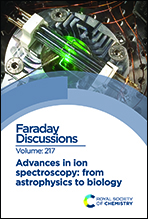Conformational assignment of gas phase peptides and their H-bonded complexes using far-IR/THz: IR-UV ion dip experiment, DFT-MD spectroscopy, and graph theory for mode assignment
Abstract
The combined approach of gas phase IR-UV ion dip spectroscopy experiments and DFT-based molecular dynamics simulations for theoretical spectroscopy reveals the 3D structures of (Ac-Phe-OMe)1,2 peptides using their far-IR/THz signatures. Both experimental and simulated IR spectra are well-resolved in the 100–800 cm−1 domain, allowing an unambiguous assignment of the conformers, that could not be achieved in other more congested spectral domains. We also present and make proofs-of-principles for our newly developed theoretical method for the assignment of (anharmonic) vibrational modes from MD simulations based on graph theory coupled to APT-weighted internal coordinates velocities DOS spectra. The principles of the method are reviewed, applications to the simple gas phase water and NMA (N-methyl-acetamide) molecules are presented, and application to the more complex (Ac-Phe-OMe)1,2 peptidic systems shows that the complexity in assigning vibrational modes from MD simulations is reduced with the graphs. Our newly developed graph-based methodology is furthermore shown to allow an easy comparison between the vibrational modes of isolated monomer(s) and their complexes, as illustrated by the (Ac-Phe-OMe)1,2 peptides.

- This article is part of the themed collection: Advances in ion spectroscopy - from astrophysics to biology


 Please wait while we load your content...
Please wait while we load your content...